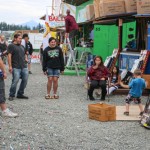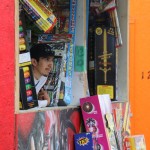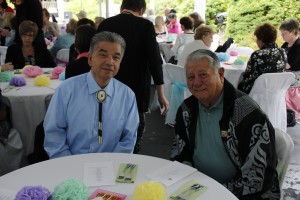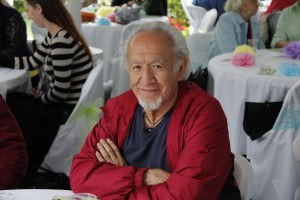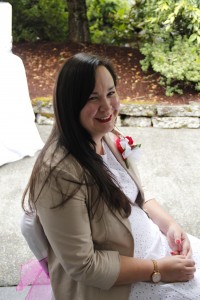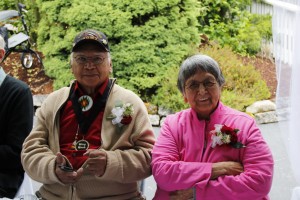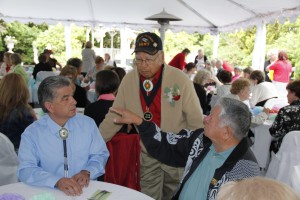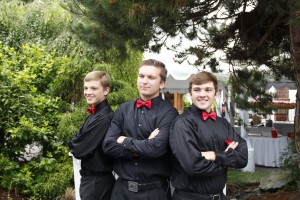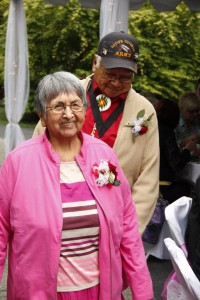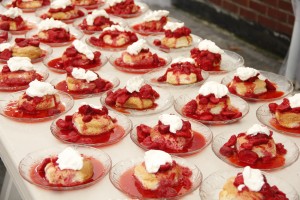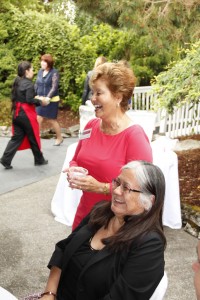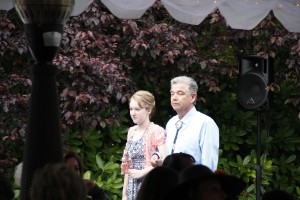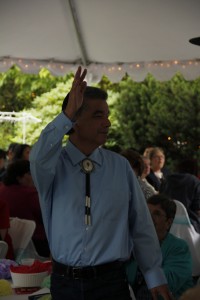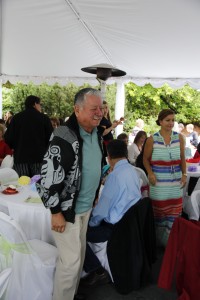Please use the following link to download the June 25, 2014 issue of the syəcəb:
Category: Tulalip News
Boom City or bust!

Tulalip Boom City opens its 35th consecutive firework season
By Brandi N. Montreuil, Tulalip News
TULALIP – “It is a demand. There are people that want to buy fireworks and they know where to go to buy them. It’s why we are here, because of those return customers,” says Pink Cadillac stand owner and Tulalip tribal member, Dan Pablo Sr., about the annual firework-selling event in Tulalip known as Boom City.
Boom City, a malaise of 8×16 foot, cleverly decorated wooden stands displaying thousands of pyrotechnic merchandise, is in its 35th year of operation. The 126 stands owners will have a little over two weeks to sell thousands of fireworks and make a profit that can range from $2,000 to $30,000.
To organize this massive event and keep stand owners and the hundreds of thousands who come to purchase fireworks each year safe, is a group of people called the Boom City Committee. The committee, consisting of five people, is responsible for site security, sanitation, and making sure Boom City policies are followed.
To ensure safety at Boom City, security personal are on-site throughout the selling season and enforce rules for stand owners and customers, such as no smoking near the stands, only lighting off fireworks in the designated discharging area, and safety in general. Tulalip Police Department also maintains an active presence at Boom City with a K9 unit, in addition to foot patrol units, who patrol to discourage illegal activity.
Committee chairman, Dan Pablo Sr., says planning for the event takes months, and that includes collecting of permit and insurance fees from stand owners before holding a drawing for stand lot numbers. After merchandise stocking and set up is finalized, Pablo says stand owners wait for the “rush,” what he calls the four days before the 4th of July.

For 35 years, millions of customers have visited and purchased fireworks for their 4th of July celebrations, at what has been described as the single largest place to buy fireworks in the Pacific Northwest and a place unlike any other. But what makes Boom City so successful?
Pablo contributes its success to the fact that customers can purchase fireworks that are illegal in Washington state, such as firecrackers, bottle rockets, missiles and sky rockets. Stand owners, who must be Tulalip tribal members 18 and over or spouses of Tulalip members to operate a stand, are legally able to sell these types of federal fireworks specifically due to the location of Boom City. Tulalip Reservation and it’s tribal citizens while they are on the Reservation, are subject to Tulalip and Federal firework laws, not State law, making the sale of fireworks exempt from state law, and it possible to possess and discharge them on tribal lands.
“I have seen prices in town that are lower than here, but our fireworks have more to them than what you can get in town, which is why they come here,” said Pablo, who also says the annual firework season presents a tremendous business opportunity to tribal members.
“It is a lot of work to do this. I look forward to it, and the extra money is a big draw. It is an opportunity to make extra money that you normally wouldn’t be able  to, but you have to have some salesmanship skills. You have to know what you have is the big thing,” said Pablo about being a successful stand owner.
to, but you have to have some salesmanship skills. You have to know what you have is the big thing,” said Pablo about being a successful stand owner.
It is not only stand owners who stand to make a profit at Boom City this year, but also Tulalip youth, 16 and over. Youth are hired during the firework season to help stock stands, run errands, and help draw in customers. Food vendors also hire youth to take and deliver food orders.
While stand owners are open two weeks before the 4th, it’s the few days before that they make most their profits.
“Selling is non-stop towards the end. There is no slow time. It is constant. It is a lot of work, and sometimes you don’t get lunch until 4:30 in the afternoon. It is that busy. But it is a lot of fun,” said Pablo.
Boom City will close on July 4, and is open daily from 6 a.m. to midnight. For more information regarding Boom City, please contact 360-716-4204. Or you can check out Boom City on Facebook.
Brandi N. Montreuil: 360-913-5402; bmontreuil@tulalipnews.com
Farewell Big Chief, safe journey home
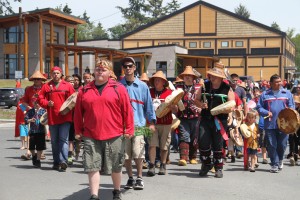
June 21, 2014, Tulalip News – Niki Cleary
The First Salmon Ceremony is a time when Tulalips honor the first King Salmon of the year. He is a representative of his people and when the people of Tulalip treat him with the respect, he returns to the salmon village carrying the message that we are worthy of the sacrifice, the life, that a salmon gives in order to feed us. It’s an ancient tradition that ensures good harvests and keeps us tied to the species that we rely on for both physical and cultural sustenance.
“This is tied to a value,” said Tulalip Board of Director and Treasurer Glen Gobin, “the value of giving thanks for the things that nature provides for us. The way we do things today may not be the same as we did 200 years ago, because many things were taken away. But as long as it’s done with good intentions and good feelings in your heart, our ancestors look at that and are happy.”
If you’ve never been to the First Salmon Ceremony, the first thing you notice is how it feels. Like a wedding or baptism, the atmosphere is somewhere between a family reunion and sacrament. Smiles, hugs and laughter permeate the ceremony. Along with the love, there are constant, gentle reminders that this isn’t just pomp and circumstance, this is a ritual that is necessary to the survival of our people.
“It’s important that the teachings we receive are passed on in the same manner we received them. If we don’t, then our future changes,” said Gobin. “It’s the young ones that will continue to carry that on.”
After describing the meaning behind the songs used in the ceremony and emphasizing that songs are considered personal property, Gobin further explained, “I tell this story every time, so that the young ones, when they hear the song, they know what it means. They know how it came to be and they can pass that onto the next generation.”
Federal Indian policy over the years has generally aimed to eradicate Native Americans as a people. Although, not as outwardly brutal as genocide, assimilation policies and cultural disconnection are considered just as damaging to tribal citizens as outright murder of the populace.
“We were supposed to assimilate into mainstream society,” Gobin said, describing the legacy of boarding schools. He continued, saying that Native Americans were supposed to lose their culture, lose their language and lose their identity.
“Through the course of time we lost much. All of our history is done in an oral manner,” said Gobin. Although much is gone, he pointed out that much has been saved as well.
“We failed to assimilate,” he said. “We failed to lose our culture.”
Gobin thanked those gathered for the ceremony, “You are here for a reason, you are here because this is a ceremony. That returning visitor (King Salmon), he knows who is here. You know the potential of the message he’ll bring to the other side.”
As the canoe took the remains of the first salmon back to the water, releasing him facing west towards the salmon village, Tulalips raised their voices in a song that means, “Farewell Big Chief, safe journey home.”
Can you stand the heat?
Tulalip Bay Fire Department runs house fire drill

Photo: Andrew Gobin/ Tulalip News
By Andrew Gobin, Tulalip News
TULALIP – A ceiling of dense smoke hung inches above our heads as Tulalip Bay Firefighters and I crouched in the burning house. Removing my glove to snap a photo from the inside, I instantly felt the intense heat that filled the room around us. Crawling towards the burning room, my hand began to burn from the heat, forcing me to put my glove back on. Sensors measured the heat in the room where the flames were to be above 600o Fahrenheit, so Tulalip Bay Fire Chief Teri Dodge splashed the flames with the fire hose. Even through protective bunker gear I could feel the heat from the blast of steam that shot out from the doorway of the room. My air tank was out so I had to get outside.
The Tulalip Bay Fire Department burned a house slated for demolition on June 14 on Mission Beach Road, across from the cemetery. They let me join them for the drill for an exclusive look at what they do, fitting me in bunker gear (firefighter boots, pants, coat, helmet, etc.) complete with an air-pack so I could safely be in the house to observe them in action.
What good is any drill without pizza? We enjoyed a lunch of four different kinds of pizza after the first round of drills were finished. Then on to the second drill, flashovers.

Photo: Andrew Gobin/Tulalip News
I didn’t understand the term, but it sounded exciting. Once more I geared up to go in, though I could only stay in for one round due to safety concerns. There we were, crouched down. A second room was set on fire during lunch and had grown to a good size blaze. I couldn’t get any pictures, having to keep all of my protective gear on. Site commander Tom Cohee was my guide for this round, taking the time to explain what firefighters look for in a fire. Going in we had to crawl. The temperature in the smoke above us was upwards of 200o, much hotter than the 110o on the ground where we were. A firefighter would spray water at the ceiling, and depending on how much came down, they could gauge the temperature of the air above. As things heated up, another ceiling spray, and a cloud of steam surged downward, making visibility so low I couldn’t see my hand in front of my face.
They didn’t spray again for a few minutes, letting the gasses and flames build for the flashover. Cohee explained that flashover is when the air above, which is filled with gasses from things burning, gets so hot that they catch fire and flash, allowing flames to extend out of the burning room, the length of the house ceiling. No sooner had he explained than a flame whipped across the ceiling, rolling down the back wall I was leaning on. A few ceiling sprays cooled the air enough to contain the flashover. I exited with the team. I was heating up in all the gear, but I didn’t realize how hot it actually was in the house. Once outside, I removed my gloves and grabbed my helmet. That was a mistake. I couldn’t touch it any more than I could touch a skillet.
I have a new appreciation for the work firefighters do.
“We train this way because we have to,” said Chief Dodge. “In a real fire, we can’t choose or control the situation we walk into. So here, we have to practice multiple scenarios. Even though it’s practice, these drills are as dangerous as a real house fire.”
Tulalip Bay Fire Department is committed to the Tulalip community. In addition to responding to emergency calls, they can be found handing out fire safety information and tips at different events, like the health fair at the Tulalip Karen I. Fryberg Health Clinic. If you see them out in the community, be sure to say hi.
Andrew Gobin: 360- 716-4188; agobin@tulalipnews.com
Tulalip tribal Chair and Vice Chair participate in annual Strawberry Festival Fashion Show
By Andrew Gobin, Tulalip News
The Marysville Strawberry festival offers much more than a parade and carnival. Every year, junior and senior high school students are selected to participate in Strawberry Court, receiving academic sholarships from the April Friesner Scholarship fund. The royalty luncheon and fashion show is an entertaining way for the community to come together to raise funds.
Royalty past and present are welcome at the event, and many people form the community seek donated clothing from local businesses to show off at the event. This year, Tulalip Chairman Herman Williams Sr. and Vice Chairman Les Parks volunteered in the show. Tulalip elder Jeannie McCoy was present, along with the Tulalip Strawberry King and Queen, Hank and Geraldine Williams. Pauline Nolan, a Tulalip elder who is involved with the strawberry festival every year, also modeled, along with our own Nicole Sieminski.
Check out the photos.
Tulalip Salmon Ceremony
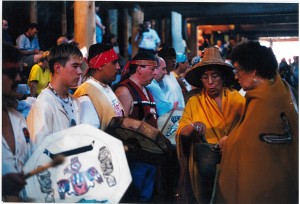
Photo courtesy of the family of Stan and Joanne Jones
Salmon Ceremony is tomorrow, June 21st, at 10:30 in the morning. Members of the Tulalip community will gather to celebrate the return of the King Salmon, and to bless the fishing fleet. The ceremony today was revived from the traditions of old, as remembered by Harriette Shelton Dover, Morris and Bertha Dan, Molly Hatch, and Daisy Williams, and others.
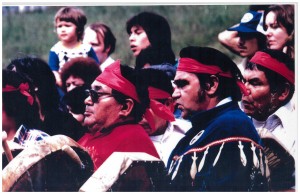
Photo courtesy of the family of Stan and Joanne Jones
Children can’t be what they can’t see
Speakers encourage and honor students at annual graduation banquet
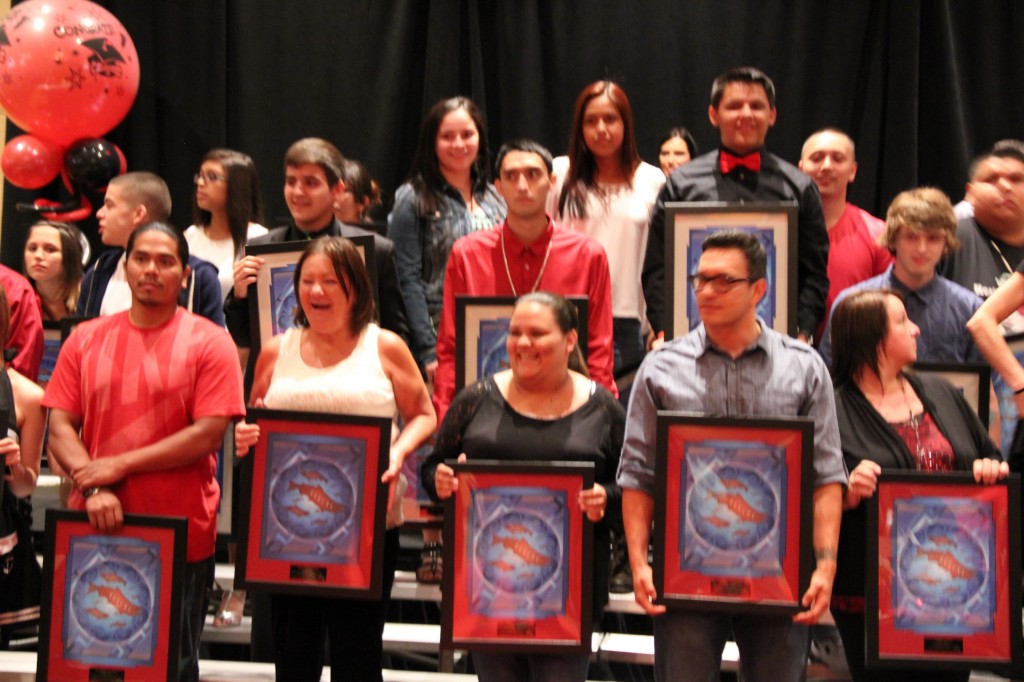
By Andrew Gobin, Tulalip News
TULALIP – The Tulalip Tribes honored all tribal members that graduated this year, as well as all other Native students who graduated from the Marysville School District, on June 13 at the Tulalip Resort. Ninety nine students graduated from high school and post-secondary education. Tribal leaders recognized the academic achievement of the students, and former Chair of the National Indian Gaming Commission, Tracie Stevens, gave an inspirational keynote speech. Student speakers expressed gratitude for many years of support, telling of their struggles and achievements.
Leticia Bumatay of the Shool Home Partnership Program (SHOPP) said, “Seven years ago, I couldn’t see myself standing here. I say seven years because that was when I lost my mom. I was bounced around with beda?chelh, so I am 21 years old getting my high school diploma today. The one thing I have to tell everybody is to never give up. Never give up on what your dreams are, never give up on your hope, and never give up on your faith. My grandma taught me that.”
Tulalip Treasurer Glen Gobin encouraged graduates to go out and see the world without the fear of losing their roots.
“You graduates here today, your whole world is out there. You can get an education or you can go to work. But one thing I just want to encourage you all, because it’s the one things that has kept us who we are today, is stay grounded in your culture, stay grounded in who you are, stay grounded and come back and help your tribe, because that what our past people have done,” he said.
Keynote speaker Tracie Stevens took the stage, introducing herself in a traditional manner. She highlighted the importance of education, and what that empowers students to accomplish for their tribe and for themselves.
“I didn’t understand what the purpose of education was, and what it would do for me later in life. I was the first person in my immediate family to graduate high school and began a 21 year journey to get a four-year degree. I worked for Tulalip from 1995 to 2009. I just decided to finish school one day. I figured out that if I went to school, at night, full time, I could finish in one year what I had been trying to for the last 20 years. I was the first in my family to get a four-year degree. The lack of a question I had when I was younger, about what education would do for me; I found later that education would expand my universe, a great deal. Which eventually led to my passion, this policy nerd that I am, which is helping my people, in any way that I could.”
Education is a journey for finding passion. In high school, some students dare to move on to college to chase their life’s passion. Others find their passion in jobs or job training. It’s all about doing what you love in the long run.
Mekalani Echevarria of Marysville Getchell High School said, “Find a passion and go with it. Life without passion is utterly boring. But don’t forget where you come from. Remember your teachings from elders and use them in daily life. Stay humble, respectful, and honest.”
Tulalip graduates were recognized for the example they are for their people.
“What kind of auntie would I be if I didn’t graduate. I had to be an example for my nieces and nephews. Not only for them, for the next generation,” said Tulalip Heritage High School graduate Santana Shopbell.
That need to be an example continues on long after graduation. Stevens talked about how she struggled with the choice of accepting the nomination to chair the National Indian Gaming Comission, knowing it would extend her time away from home.
“A woman I worked with, Rene Stone, told me, ‘How will all those Indian boys and girls, that are growing up now, ever know that they can come this far and do this kind of work if they don’t see you out front leading? Children can’t be what they can’t see,’” Stevens recalled. “You all have reached an important benchmark, and with that you are breaking a cycle of an old failed Indian Education policy that was meant to take the Indian out of you. We can do more than just survive, we can thrive and prosper. You’ll use your education, your knowledge, to pass that on to the next generation, to change the history of Indian Education so that we control our own destiny. Be the example, be the change, and be the one that passes that on.”

Ninety nine graduates this year. Ninety nine examples of hard work and dedication. Ninety nine examples of success and achievement, overcoming adversity in so many ways. Congratulation to all graduates of 2014.
Andrew Gobin is a staff reporter with the Tulalip News See-Yaht-Sub, a publication of the Tulalip Tribes Communications Department.
Email: agobin@tulalipnews.com
Phone: (360) 716.4188
Tulalip TV mentor young filmmakers during film project
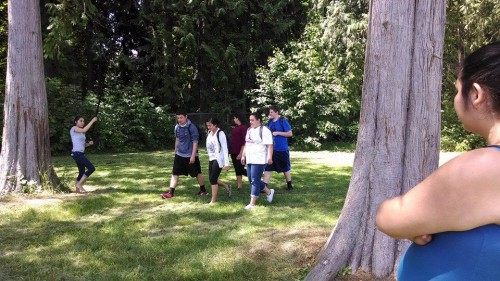
Photo/ Brandi N. Montreuil, Tulalip News
By Brandi N. Montreuil, Tulalip News
TULALIP – Quiet on set. Camera frame. Speed. Mark it. Action!
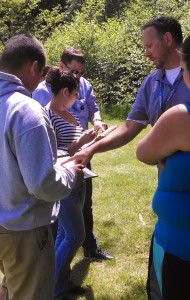
Photo/ Brandi N. Montreuil, Tulalip News
Tulalip Heritage High School students recently held their filmmaking debut on Friday, June 13, with a little help from Tulalip TV, subsidiary of Tulalip Tribes Communications. Through a unique collaboration between Heritage High School and Tulalip TV, multi-media students received a crash course on film production to produce a short film titled, “Lady of the Woods.”
The project, created by Heritage principal Shelly Lacy and Heritage teacher Cerissa Gobin, required students to not only learn pre and post- film production and editing, but also to create a script and act it out.
“A lot of times, as viewers, we don’t think about how a movie comes together,” said Niki Cleary, Tulalip Tribes Communications Director. “This gave our youth a chance to see that it doesn’t happen all at once from start to finish. They had the fun experience of shooting scenes out of sequence. The scenes, which happen one right after another in the movie, were shot on different days. Unfortunately, the students forgot to wear the same clothing, which made for some continuity issues, but really helped them learn some of the basic principles
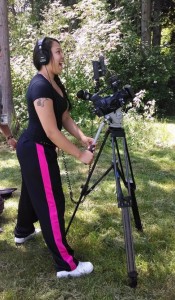
Photo/ Brandi N. Montreuil, Tulalip News
of movie production.”
The short film, which started off initially as a game show in brain storming sessions, provided students the entire film production process on a limited schedule. This included learning filmmaking terminology, which to untrained ears, sounds a lot like random dialogue being yelled out by the director from behind the camera. Roll camera. Tilt. Speed frame. Fade in.
“I am very happy with what we were able to accomplish in such a short period of time,” said Brian Berry, director of video for Tulalip TV, who worked with students throughout the filming. “We all knew that we were working against the clock, and that was one of the skills that the students learned, time management with regard to productions. We saw a lot of interest from many of the students and we hope this spark will ignite a growing base of students who want to continue with this type of study and possibly career path.”
That’s a wrap. As part of the filmmaking process, students debuted “Lady in the Woods” to underclassmen during the last days of school completing their filmmaking process.
“The student participation has been amazing. Although listening to the lecture portion of class was tough, they really engaged once they got hands on with the equipment,” said Cleary. “Ultimately, we hope to train the Heritage students to the point that they are able to cover Heritage Sports with a student staffed video crew. The skills they learn can also be used to

Photo/ Brandi N. Montreuil, Tulalip News
produce a Heritage news program, public service announcements or any number of exciting video projects. We hope that the students who learn video skills at Heritage will be the next generation of Communications Department employees.”
Brandi N. Montreuil: 360-913-5402; bmontreuil@tulalipnews.com
June 18, 2014 syəcəb
Tulalip adopts Good Samaritan Law with Lois Luella Jones Law
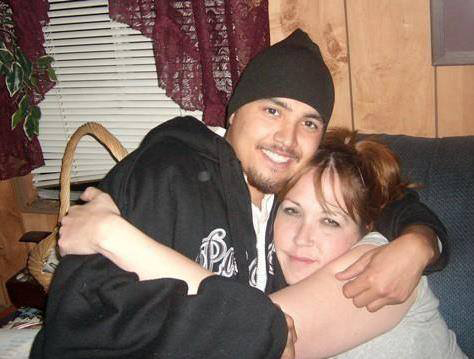
Photo Courtesy/ Rico Jones-Fernandez
By Brandi N. Montreuil, Tulalip News
TULALIP – For the past few months Rico Jones-Fernandez has campaigned to enact a Good Samaritan Law on the Tulalip Reservation that would provide temporary immunity for people seeking help from 911 emergency services for victims of drug or alcohol overdose. On June 7, his campaign came to an end when the Tulalip Board of Directors voted unanimously to enact the Lois Luella Jones Law into the Tulalip Tribal Codes.
While Jones-Fernandez’s dedication paid off for future victims of overdose, his dedication stemmed from personal tragedy.
Lois ‘Lou Lou’ Luella Jones is described as a compassionate woman, who loved to laugh and be with her family and friends. She was a proud mother of five children and had grandmother bragging rights over three grandchildren, whom she intended to be close with. But on July 10, 2010, at the age of 41, Lou Lou succumbed to what the coroner’s office, labeled as acute intoxication due to combined effects of oxycodone carisoprodol and acetaminophen. A drug overdose. Her son Rico believes it was a death that could have been prevented if the people in the house with her at the time of the overdose had called 911 for emergency help, without fear of arrest or conviction.
“I wonder what I could have done everyday,” says Jones-Fernandez. “I know there are a lot of people who are sitting and wondering what they could do for their loved ones, and there isn’t much you can do except tell them you are there for them. And with this law, at least people have the peace of mind in knowing if something does happen, someone can call 911 without fear of getting arrested. This is about not waiting for someone you love to die.”
On April 13 of this year, Jones-Fernandez introduced an early version of the law to the Tulalip Board of Directors. The draft became known informally as draft 1 after a proposed version of the law was presented by Tulalip Legal Department, known as draft 2.

Photo/ Brandi N. Montreuil, Tulalip News
The two drafts, although proposed to encourage people to report emergencies without fear of self-incrimination, contained vastly different language and protections for the person seeking medical help for a victim of an overdose.
Draft 1 proposed guaranteed immunity for persons seeking medical help from being arrested due to possession of illicit substances or paraphernalia charges, underage drinking, or contributing to a minor, including non-violent misdemeanor warrants. Protection for the caller also included the removal of probation being revoked or modified, and immunity to extend to all present that cooperated with medical staff.
Draft 2 proposed protection from arrest due to possession of illicit substances and police retain the power to arrest but encourage discretion, including the ability to use the law as a defense later in court if arrested.
Jones-Fernandez stated the differences in his draft are not about condoning the crimes, but that life is more important.
Tulalip Tribes BOD agreed and passed draft 1 during a regular Board meeting, making the Lois Luella Jones Law effective following a brief 10-day filing with the Bureau of Indian Affairs.
Although minor changes were made to draft 1 before it’s approval with the Board, the draft still retained its original language and intent, and can be used immediately.
“I’ve talked to hundreds of people about this law, and read everything I could get my hands on. It has come a long way; it has been challenging, but this is going to make things better. It is a good start. It is a great first step that will be effective,” said Jones-Fernandez.
Brandi N. Montreuil: 360-913-5402; bmontreuil@tulalipnews.com





















